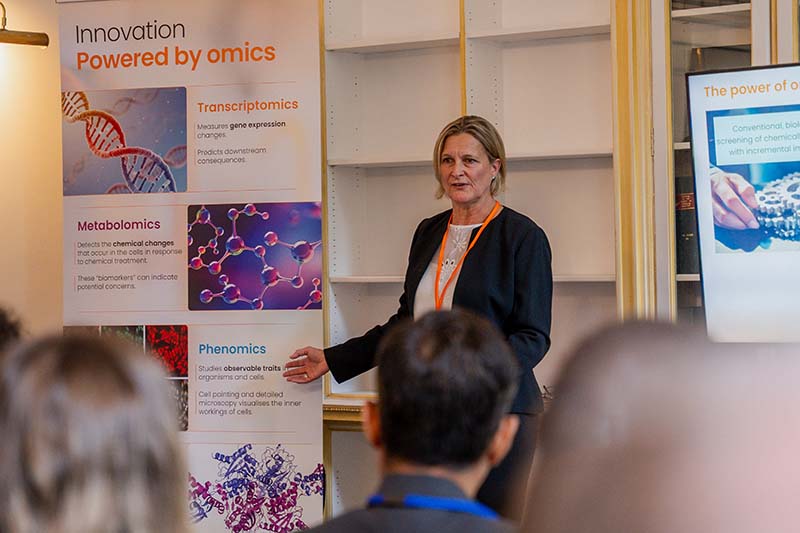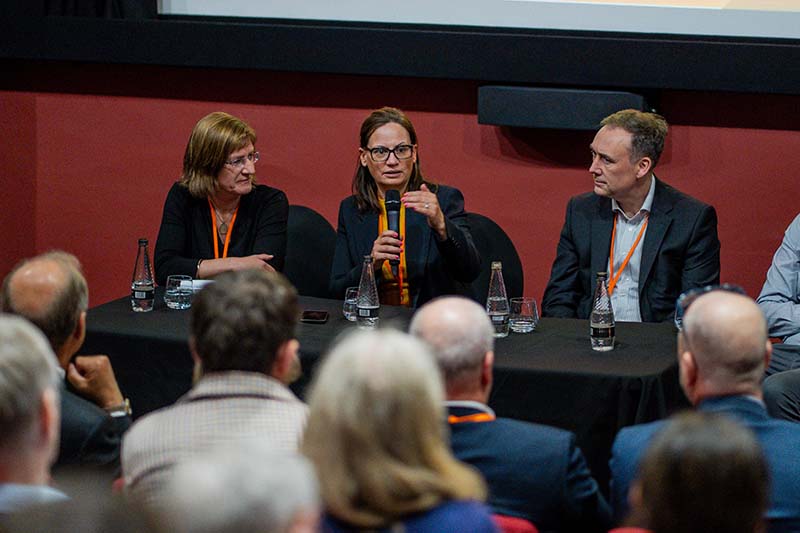Prevailing global challenges in agriculture require an increasing number of scientific and technological tools to help tackle and mitigate them. Alongside the technology is an expanding cross disciplinary and multistakeholder approach ensuring that solutions developed are safe, sustainable and equitable.
Over the last 25 years Syngenta, the global agri-life sciences business, has positioned itself to make full use of new tools and multidisciplinary approaches to support its many innovations across the agricultural sector. Convening industry stakeholders, trade bodies, learned societies and academic collaborators, the company used its 2025 Connected Innovation Showcase, held in London in partnership with SCI on 4 June, to share how some of the newest science is being used to support farmers and the agricultural sector, as well as share its vision for what a sustainable future will look like.
Not a time to stand still
“Customers are hungry for innovation. Across the agricultural sectors we have a wide range of stakeholders, and collaboration is the way we are moving forward,” said Sarah Iveson, Syngenta Commercial Unit Head, Northwest Europe, opening the event.
The innovation that Syngenta’s customers are seeking must support feeding a growing population while maintaining biodiversity, protecting soils, addressing the challenges of a changing climate, optimising the use of chemicals and other inputs, and supporting the lives of farmers and their families.
“We are investing in chemical and biological crop protection technologies, developing high performing seeds, using digital tools that support decision making and helping farmers adapt to sustainable and regenerative approaches,” Iveson added.
Parallels with the pharmaceutical sector
Syngenta’s approach to R&D has many analogies to the pharmaceutical sector, particularly in the employment of omics technologies: genomics, transcriptomics, phenomics, proteomics, and metabolomics, to enable the design of modern, safe crop protection chemicals.
Naomi Pain, Predictive Science head (Images Syngenta)
As Naomi Pain, Predictive Science Head, and Richard Dale, Syngenta Fellow explain, “omics has allowed for a shift from effects-led screening to fundamentally understanding the mechanisms by which the species we want to control and those we want to protect, function.” This has great impact on research into aspects of crop protection for example herbicide resistance and weed control. “We can investigate complex molecular interactions. This has many benefits in the development and assessment of efficacy and safety of new crop protection products and bio-stimulants for enhancing plant health,” Pain commented.
It is hoped that in the future omic technologies will impact the tools available to farmers and agronomists. This may be via simple devices that allow data to be gathered in field, providing for accurate diagnosis and actions when crop problems arise.
New Modes of Action
This use of new technologies to better understand what it is happening at cellular and molecular levels allows for improved accuracy in developing targeted solutions, particularly around crop pest and disease prevention and eradication.
“We are now in a position to pinpoint our targets, when it comes to crop protection,” said Sarah Sulzer, Head of Crop Protection Research Chemistry at Syngenta “This is revolutionising how we do discovery and, importantly, how we build in sustainability.”
Sarah Sulzer, Head of Crop Protection Research Chemistry at Syngena (Centre) along with Jutta Boehmer and Luke Gibbs (Images Syngenta)
A recent development in this area for Syngenta comes from it is collaboration with AI-informed crop health company Enko, where the partners are working to discover novel solutions for weed and disease control to bring much-needed innovation to farmers.
The collaboration is focused on new, specific MoA, (mode of action) which is part of Syngenta’s “Safer by Design” research strategy that aims to deliver higher yields while lowering the impact to the planet through more sustainable technologies. The discovery of new leads was made using Enko’s ENKOMPASSTM DNA-Encoded Library (DEL) platform, which promises to reduce time and cost compared to conventional R&D approaches.
As weeds become more resistant to existing treatments, the impact on crop yields can be devastating. Syngenta says it is estimated that the total crop losses to weeds worldwide is some $32 billion a year. Finding new ways to tackle resistant weeds is critical, with new MoA playing an important role. New MoA are also vital to tackle the insect pests and diseases that impact crop yields.
Understanding complex proteins
Innovation in protein science is an area providing a major step forward in agriscience, with a range of advanced computational and experimental methods providing greater understanding of protein structure and function. This is already impacting the development new herbicide and other crop protection molecules.
Computational models can be used to explore how a target molecule interacts with a key protein. With a range of tools available to study protein structure and molecular interactions, there is great scope for creating products that can be selectively targeted and optimised.
All of these technologies and more are supported using artificial intelligence - analysing data, building models and predicting properties - and so provide faster and more accurate decision making which is ultimately ensuring innovation continues to make it to the marketplace and reach the growers.
A collaborative effort
As Syngenta’s team reiterated across the half day ‘Connected Innovation’ event, tackling the challenges that agriculture is facing is not something that any one organisation can do alone. Collaboration is key. To this end the company shared its 'Shoots by Syngenta' initiative, which it describes as ‘a global platform built on the values of openness and transparency.” Launched in 2023, the platform seeks innovative ideas and proposals to solve major challenges and has led to collaborations with several companies and academic groups.
The work carried out by Syngenta and its collaborators ultimately has one focus: providing sustainable access to nutritious and affordable food around the world. It is widely agreed that a systems transformation is required to achieve this end. And while the science is integral, Dave Hughes, Head of Technology Identification and Evaluation at Syngenta stressed that: “The system must be – and seen to be – socially responsible and equitable.”


